
The Second Balkan War was a conflict that broke out when Bulgaria, dissatisfied with its share of the spoils of the First Balkan War, attacked its former allies, Serbia and Greece, on 16 (O.S.) / 29 (N.S.) June 1913. Serbian and Greek armies repulsed the Bulgarian offensive and counterattacked, entering Bulgaria. With Bulgaria also having previously engaged in territorial disputes with Romania and the bulk of Bulgarian forces engaged in the south, the prospect of an easy victory incited Romanian intervention against Bulgaria. The Ottoman Empire also took advantage of the situation to regain some lost territories from the previous war. When Romanian troops approached the capital Sofia, Bulgaria asked for an armistice, resulting in the Treaty of Bucharest, in which Bulgaria had to cede portions of its First Balkan War gains to Serbia, Greece and Romania. In the Treaty of Constantinople, it lost Adrianople to the Ottomans.

Victory Day is a holiday that commemorates the victory of the Soviet Union over Nazi Germany in 1945. It was first inaugurated in the 15 republics of the Soviet Union following the signing of the German Instrument of Surrender late in the evening on 8 May 1945. The Soviet government announced the victory early on 9 May after the signing ceremony in Berlin. Although the official inauguration occurred in 1945, the holiday became a non-labor day only in 1965.

The Brusilov offensive, also known as the "June advance", of June to September 1916 was the Russian Empire's greatest feat of arms during World War I, and among the most lethal offensives in world history. The historian Graydon Tunstall called the Brusilov offensive the worst crisis of World War I for Austria-Hungary and the Triple Entente's greatest victory, but it came at a tremendous loss of life. It was arguably the most successful offensive in the entirety of the First World War. The victory contributed to a morale upsurge among the Russian troops, in 1917, Nicholas II planned a general offensive along the entire front in order to end the Central Powers. After the victory, the Petrograd conference was held at which the post-war structure of the world was discussed. Even despite the losses, the Russian armies were still being reinforced with new forces, the number of weapons increased, and new railways were being built.

Snake Island, also known as Serpent Island, White Island, Island of Achilles or Zmiinyi Island, is a Ukrainian island located in the Black Sea, near the Danube Delta, with an important role in delimiting Ukrainian territorial waters.

The Eastern Front or Eastern Theater of World War I, for Russia Second Patriotic War, was a theater of operations that encompassed at its greatest extent the entire frontier between Russia and Romania on one side and Austria-Hungary, Bulgaria, the Ottoman Empire, and Germany on the other. It ranged from the Baltic Sea in the north to the Black Sea in the south, involved most of Eastern Europe, and stretched deep into Central Europe. The term contrasts with the Western Front, which was being fought in Belgium and France.

The Treaty of Bucharest between the Ottoman Empire and the Russian Empire, was signed on 28 May 1812, in Manuc's Inn in Bucharest, and ratified on 5 July 1812, at the end of the Russo-Turkish War of 1806–1812. The Ottomans had done poorly in the war. The Sublime Porte above all wanted to stay out of the impending conflict between Napoleon's France and Russia. The Russians did not want a war on two fronts, thus they made peace in order to be free for the upcoming war with France. The Ottomans had extricated themselves from a potentially disastrous war with a slight loss of territory. This treaty became the basis for future Russo-Ottoman relations.

Khotyn is a city in Dnistrovskyi Raion, Chernivtsi Oblast of western Ukraine, located south-west of Kamianets-Podilskyi. It hosts the administration of Khotyn urban hromada, one of the hromadas of Ukraine. According to the 2001 Ukrainian census, it has a population of 11,124. Current population: 8,936.

The Transnistria War was an armed conflict that broke out on 2 November 1990 in Dubăsari between pro-Transnistria forces, including the Transnistrian Republican Guard, militia and neo-Cossack units, which were supported by elements of the Russian 14th Army, and pro-Moldovan forces, including Moldovan troops and police.

The Allies, the Entente or the Triple Entente was an international military coalition of countries led by France, the United Kingdom, Russia, the United States, Italy, and Japan against the Central Powers of Germany, Austria-Hungary, the Ottoman Empire, and Bulgaria in World War I (1914–1918).
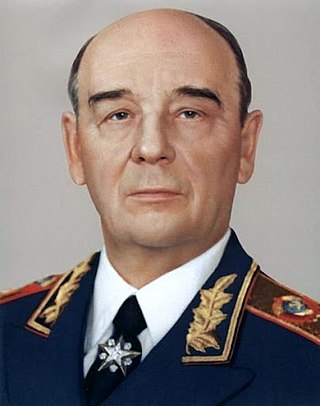
Sergei Leonidovich Sokolov was a Soviet military commander, Hero of the Soviet Union, and served as Minister of Defence of the Soviet Union from 22 December 1984 until 29 May 1987.
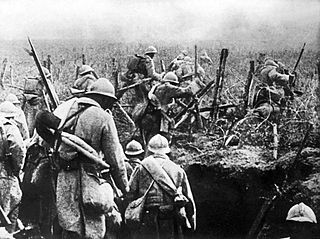
World War I or the First World War, also known as the Great War, was a global conflict between two coalitions: the Allies and the Central Powers. Fighting took place mainly in Europe and the Middle East, as well as in parts of Africa and the Asia-Pacific, and in Europe was characterised by trench warfare and the use of artillery, machine guns, and chemical weapons (gas). World War I was one of the deadliest conflicts in history, resulting in an estimated 9 million military dead and 23 million wounded, plus up to 8 million civilian deaths from causes including genocide. The movement of large numbers of people was a major factor in the Spanish flu pandemic, which killed millions.

The Kingdom of Romania was neutral for the first two years of World War I, entering on the side of the Allied powers from 27 August 1916 until Central Power occupation led to the Treaty of Bucharest in May 1918, before reentering the war on 10 November 1918. It had the most significant oil fields in Europe, and Germany eagerly bought its petroleum, as well as food exports.

409 Tactical Fighter Squadron is a unit of the Royal Canadian Air Force. The squadron operates the CF-18 Hornet from CFB Cold Lake in Alberta, Canada.
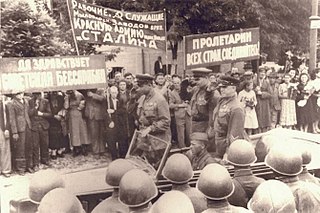
Between 28 June and 3 July 1940, the Soviet Union occupied Bessarabia and Northern Bukovina, following an ultimatum made to Romania on 26 June 1940 that threatened the use of force. Those regions, with a total area of 50,762 km2 (19,599 sq mi) and a population of 3,776,309 inhabitants, were incorporated into the Soviet Union. On 26 October 1940, six Romanian islands on the Chilia branch of the Danube, with an area of 23.75 km2 (9.17 sq mi), were also occupied by the Soviet Army.
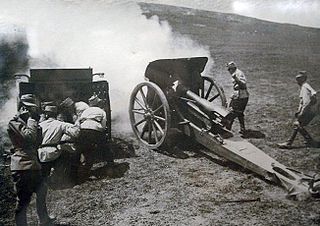
The Battle of Mărăști was one of the main battles to take place on Romanian soil in World War I. It was fought between 22 July and 1 August 1917, and was an offensive operation of the Romanian and Russian armies intended to encircle and destroy the German 9th Army. The operation was planned to occur in tandem with the Nămoloasa offensive; however, this operation was abandoned before it began.

The Hungarian–Romanian War was fought between Hungary and Romania from 13 November 1918 to 3 August 1919. The conflict had a complex background, with often contradictory motivations for the parties involved.
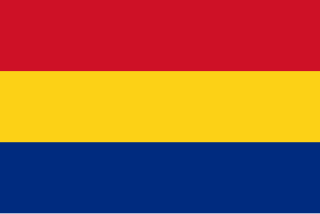
The United Principalities of Moldavia and Wallachia, commonly called United Principalities or Wallachia and Moldavia, was the personal union of the Principality of Moldavia and the Principality of Wallachia. The union was formed 5 February [O.S. 24 January] 1859 when Alexandru Ioan Cuza was elected as the Domnitor of both principalities. Their separate autonomous vassalage in the Ottoman Empire continued with the unification of both principalities. On 3 February [O.S. 22 January] 1862, Moldavia and Wallachia formally united to create the Romanian United Principalities, the core of the Romanian nation state.
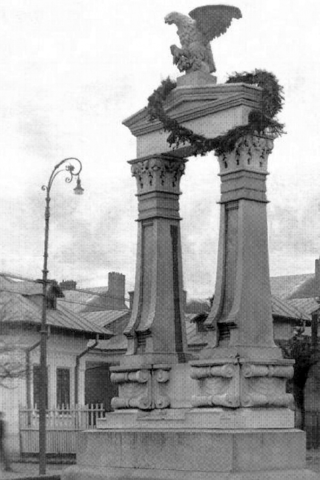
The Battle of Galați was a military engagement between the formerly allied Romanian and Russian troops at the end of World War I, as the former sought to prevent the latter from retreating from the armistice line along with their equipment.
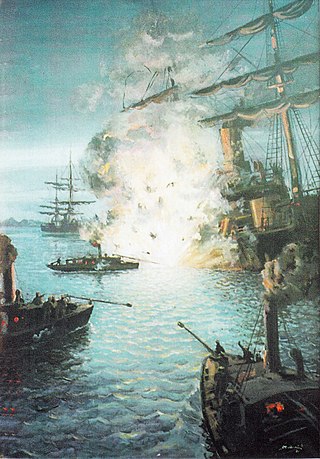
The action off Măcin was a naval engagement between a torpedo boat of the Romanian Navy with a mixed Romanian-Russian crew, together with another 3 Russian torpedo boats, and a monitor of the Ottoman Navy which took place during the 1877-1878 Russo-Turkish War. It was the first time in history that a torpedo craft sank its target without being sunk itself.


















